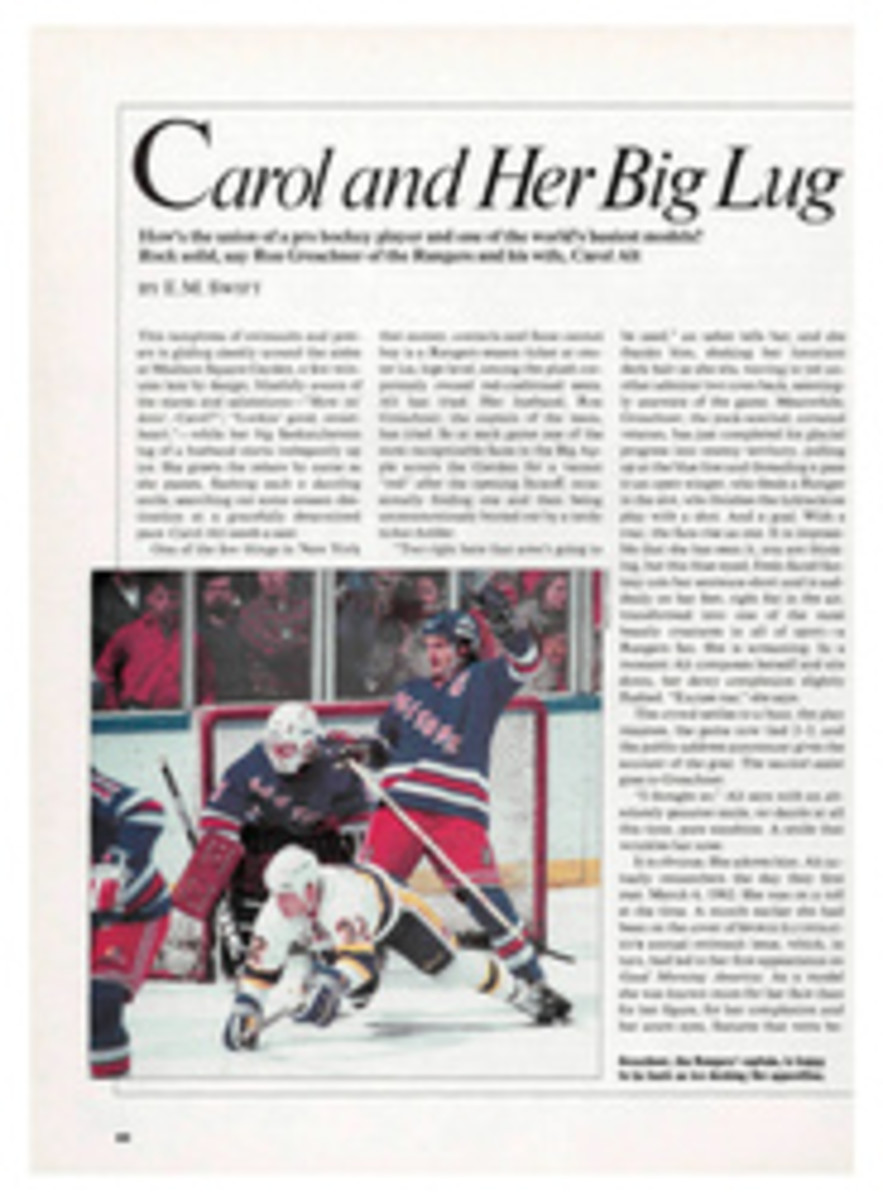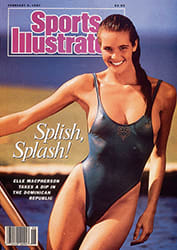
EYEING WAYS TO IMPROVE PERFORMANCE
In most sports nothing affects performance more than the ability to see clearly and correctly. Whether an athlete is tracking a fly ball, returning a serve or throwing a pass, it is his eyes that lead his body.
Until recently most athletes took their eyesight for granted. But according to Dr. James Carlson, chairman of the American Optometric Association's Sports Vision Section, some 3,000 optometrists now work with athletes, from peewees to Olympians to pros.
The most obvious way that optometrists help is by prescribing aids for athletes to wear: corrective lenses, lenses tinted for various light conditions, goggles made of transparent polycarbonate for eye protection.
But beyond that, optometrists are also training athletes' visual systems to perform better. Dr. Alan Reichow, who works with at least 70 athletes each year at Pacific University in Forest Grove, Ore., says that although athletes generally see better than non-athletes, even they have room for improvement. "If an athlete is motivated and you challenge him with visual drills clearly relevant to his sport, his athletic performance will improve," says Reichow. "I have yet to see an exception."
Sports vision specialists still begin with the familiar eye-chart test, but this only gauges an athlete's static vision—the ability of a stationary person to see a stationary object. Going further, they also test the complementary skills in an athlete's visual system, from the ability to recognize a situation instantly and react to it swiftly, to the ability to shift focus quickly and accurately, or to track moving objects and judge their distance, speed and direction. In the new Vision Testing and Performance Laboratory at the U.S. Olympic Training Center in Colorado Springs, an athlete in a visually demanding sport like baseball may undergo as many as 45 different tests.
Next the optometrist supervises drills. His emphasis is twofold: to enhance the entire range of visual skills, and to correct any significant visual shortcomings.
Dr. William Harrison of Laguna Beach, Calif., one of the first optometrists to work with athletes, gives three examples of how their needs and training can differ:
•"At the Kansas City Royals' baseball academy back in 1971, I examined an 18-year-old kid named George Brett. He had hit pretty well in rookie ball, but he had a serious handicap.
"Every time George blinked, that slight visual disruption caused him to have blurred or double vision for a split second afterward. He compensated by staring, and he walked around with eyes as big as silver dollars. But it was impossible to do this all through a game.
"I had him wear polarized glasses and use a vectogram—a device with two polarized pictures that you view at arm's length. George had to separate the pictures manually in various directions, while making his eyes and brain fuse them into one perfect, three-dimensional picture. After only two weeks of daily half-hour drills, his eyes worked so well together that blinking no longer impaired his vision.
•"CART driver Roberto Guerrero was referred to me after a visual screening at the 1984 Indy 500. Roberto had miserable depth perception because his right eye was much weaker than his left, and he wasn't using it.
"I trained him on an Accommotrac, a biofeedback machine that teaches people how to control the ciliary muscles attached to the lenses of their eyes. Vision in Roberto's right eye improved from 20/30 to 20/15, and in his left from 20/15 to 20/10. After this reduction in the difference between his eyes a test placed his depth perception in the top 1% of the population.
•"Jim Simons, the PGA golfer, came to me in 1977 with a concentration problem. His vision was fine when he was sitting in an exam chair, but it was disturbed when he was slightly off-balance—standíng on a sidehill lie or even putting in a strong wind.
"My drills taught his visual system to function while he was off-balance. He read an eye chart while bouncing on a trampoline. He shifted focus among different targets while balancing side-to-side on a beam. He used the Vectogram while walking on a rail.
"Jim has needed follow-up work more than most athletes, but now he feels more stable over his shots."
For his part, Simons has become a believer in Harrison's methods. "I still do visual exercises using portable equipment like a mini-trampoline or a balance board," says Simons. "When I train regularly there is a real improvement in my golf game, especially in my concentration."
Dr. Harrison's examples may seem out of the ordinary to a layman, but other optometrists, who are reluctant to divulge patients' names, offer similar cases of athletes hampered by correctable vision problems. Some of the examples they give are:
•An NFL receiver who wasn't able to track balls coming over his right shoulder until a doctor worked out a special training program to teach his eyes to function together more accurately.
•An NBA player who missed two-thirds of his free throw attempts during his career because his eyes told his brain that the basket was a foot short and 10 inches to the left of its actual location.
•A volleyball player from the '84 Olympic team who mishit overhead shots under stress because he suppressed vision from one eye.
Obviously, vision problems are individual and complex. Thus responsible optometrists criticize colleagues who promote unsupervised training programs, whether taken from books or based on such devices as interactive videotapes or computerized boards of flashing lights. Dr. Donald Teig of Ridgefield, Conn., who has tested eight major league teams and dozens of pro tennis players, says, "You need a professional to test you and tell you what drills to do and how to do them. Otherwise, you can end up worse than you started."
Many optometrists, however, do supplement players' supervised training with advice on how they can prepare for competition on their own. They teach short pregame visual warmups that don't require props. They also give advice on exercises to relieve visual fatigue, such as shifting focus between near and far objects. And they pass along universally helpful practice techniques, some borrowed from coaches or players.
One drill, popular with Pete Rose, sharpens a hitter's recognition and reaction skill by having him take batting practice 10 to 12 feet in front of home plate. Another drill, developed by Vince Lombardi, improves the visual concentration of receivers. The quarterback throws footballs that are numbered on the front tip; the receiver has to call out the number as the ball approaches.
Some optometrists teach athletes how to improve their vision not just for an instant, but for a sequence of actions. For example Dr. Teig gives the following advice to hitters in baseball:
"Position your head so that your dominant eye—the one eye you naturally aim with—will have a clear line of sight to the pitch. Watch the pitcher with a relaxed focus until the ball is released, and then fine-tune on the ball. Minimize your head motion, refrain from thinking, and follow the ball with your eyes smoothly as long as possible before swinging."
Optometrists, as well as many psychologists and physiologists, suggest that an athlete ingrain correct visual habits with mental rehearsals. With eyes closed, he should picture himself successfully carrying out an action. This practice, called visualization, is most likely to improve actions that can be duplicated in competition, such as driving a golf ball or shooting a free throw. Indeed, an Australian study shows that basketball players who mentally rehearsed free throw shooting improved their accuracy by an average of 23% over players who didn't.
Athletes vary in their compliance with optometrists' advice, but those eager for a competitive edge usually pay attention. One of the most enthusiastic disciples is Kiki Vandeweghe, the sharp-shooting forward of the Portland Trail Blazers.
During Vandeweghe's time with the Denver Nuggets, Dr. Craig Farnsworth, a team consultant, discovered that Vandeweghe's eyes tended not to work together when he was tired. Changing his focal target as the game progressed helped correct the problem. Farns worth also taught Vandeweghe a full range of visual drills that he still does faithfully.
"I incorporate my exercises into daily life," says Vandeweghe. "I heighten my peripheral awareness by noticing items in store windows while I walk along with my eyes aimed straight ahead. Or I sit and visualize shooting from different locations. Or I concentrate on one object while I'm talking on the phone. Or, outdoors, I switch focus up and down, left and right, near and far.
"These exercises help in too many ways to count—being aware of where to pass or help out on defense, shooting the same way each time, concentrating on the basket, switching focus from the basket to a teammate. In a sport where you have to react quickly and correctly, your eyes are just too important an asset to disregard."
Optometrists are confident that athletes will eventually accept visual training as standard procedure. They're probably right. As strength training has proved its worth, visual conditioning will gain more and more converts. For athletes, seeing better will be believing.
TWO ILLUSTRATIONS
DAVID LESH
Arnold Schechter writes frequently about medicine for this magazine.

